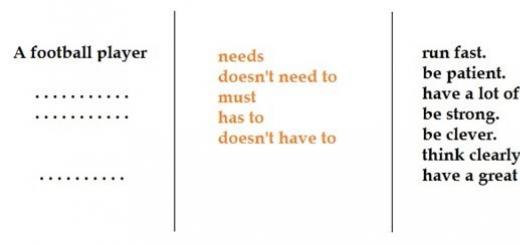In my previous article, I talked about one of the NLP techniques, namely about anchors and setting them for yourself. In this article I would like to continue this interesting and undoubtedly very useful topic and tell other people about setting an anchor; this process in NLP is called anchoring. Let me remind you once again what an anchor is and how it works: an anchor is any external stimulus, irritant, something that precedes a conditioned reflex, for example, a visual image, auditory, olfactory or kinesthetic, everything that affects our senses. An anchor causes a person’s reaction, this reaction is a certain internal state of a person, for example, an external stimulus causes a feeling of fear in a person, or simply attracts his attention, for example, ringing a bell or knocking a hammer on a table, as happens in court, draws his attention to him audience. Anchors can be installed and thereby controlled by your internal state, that is, causing the resource you need, a feeling of satisfaction, concentration, various emotional states, such as resentment, anger, feelings of joy, and so on and so forth.
But as you understand, you can set anchors not only for yourself, but also for other people, and use them to access other people’s resources, causing, for example, a person to feel shame, pity, or trust in you. If you use this technique exclusively for your own purposes, achieving a desired result that meets exclusively your interests, then this can be called manipulation of the behavior of other people, which I will now tell you about in more detail. In part, setting an anchor is reminiscent of hypnosis, and to some extent it is, only in a less overt form; after all, you do not zombify a person so much that he fulfills all your desires unquestioningly. Although those people who have perfectly learned to establish anchors and have strong suggestion are able to put people into a hypnotic state, I have witnessed such sessions many times, very impressive, I must say. But I’ll tell you about hypnosis some other time, but for now let’s return to installing anchors, which is also a very fascinating process that can influence people, both positively and negatively.
First of all, it is necessary to identify the group of people on whom it is easiest to anchor - these are people with a developed right hemisphere of the brain. Such people do not think in a structured way; they rely more on the senses and sensations, acting intuitively, without analyzing or rethinking the information received by them. But this does not mean at all that these people are not inclined to think, and therefore it is not possible to install an anchor on everyone, that is, with some people it is more difficult to do this. Having decided to put an anchor on a person, it is necessary to find out which of the organs of perception is the main one for him; installing an anchor through this organ will be the most effective. That is, you need to determine what type of person is in front of you: visual - better perceives information through vision, auditory - the best way for them to perceive information is the auditory channel, a kinesthetic person - a person who predominantly feels rather than sees, hears or thinks, or such a type of people as discretes - that is, people who perceive information for the most part with the help of logical thinking, understanding the information received to them, with the help numbers, facts, various signs and logical arguments.
Of course, it is not necessary that only an anchor similar to their channel of perception will work; installing other anchors will also give results, but what is closer to these people will work best. Although the kinesthetic method of setting an anchor is considered the most effective, sensations still store information in memory best, in most cases. Now about the process of setting an anchor, which comes down to creating a certain environment for a person in which he feels as comfortable as possible. Anchoring can happen in any way; you can have a casual conversation about a person’s past, returning to which he experiences positive emotions that are pacifying in nature. That is, in any way you need to create for the other person the most favorable environment in which he feels as comfortable, calm, and at ease as possible.
Music, smells, visual environment, your words, behavior and of course touches, including from the person with whom you are anchoring. That is, everything is ingeniously simple, certain actions on your part lay this favorable environment in a person’s memory, you can touch a person’s hand in a certain way, say pleasant words, ask, for example, to do something casual, so that it remains in memory as an action accompanying the situation. Subsequently, when reproducing some moments from this situation, they will evoke in the person memories of her, about you, and will bring him to the state in which the person was when the anchor was installed. That is, if you wanted to be remembered as positive personality, then the associations associated with the situation that you created will remind the person of you, and naturally it will be a pleasant memory.
Regarding setting an anchor through memories, which I mentioned, the meaning here is to evoke certain emotions in a person with the help of memories, as happens during hypnosis, and associating this situation with oneself. That is, you ask the person to remember the pleasant moments of his life, and when he is at the peak of emotional experiences, perform some action, for example, touch and say pleasant words, that is, those positive memories in which the person is, allow your presence, In this way, for example, you can achieve trust in yourself on the part of this person and much more. An anchor can be installed in a similar way. evoking feeling fear, associating certain actions with a negative feeling for a person, a simple example of swinging a hand at a person, which can cause him to feel fear or another response if he was often beaten. Let's say, if you want to anchor a child in order to prevent him from getting into the socket, then you must induce fear in him in any way convenient for you every time he approaches the socket, for example, emotionally explain to him how scary it is, the more emotions, the better, or just slap him on the wrist.
This is information for the subconscious, which gives a reflexive reaction; a person is afraid of something other than what is in him. this moment, but what once was, and the current situation simply gives him this feeling. I think the meaning is clear to you, since there can be a lot of situations in each specific case, as I mentioned earlier in my first article on anchors, this topic is quite deep, but studying it is interesting and useful. I would also like to tell you about setting an anchor through indirect influence on a person, that is, creating a certain myth about yourself, in the form of a positive or negative image, depending on what you need. This is done by people who create a positive image in the eyes of the public, for example, for some pop star or politician, that is, associations associated with him are artificially created for a person. For example, political figure against the background of children, family, against the background of workers communicating with him and similar tricks, create the impression in people of such a person as someone from their world.
Thus, an anchor is established for the positive attitude of some people towards others, without direct influence, but in an indirect way.
In general, I’ll tell you this, calling up certain memories in a person and thereby creating a certain internal state, already sets his anchor on you as a positive or negative person. This will be the so-called first impression that you can create on a person by talking to him about a certain topic. You can make it, this impression, the way you want, if you approach this issue with the utmost seriousness, controlling every word you say. If you force a person to remember the most terrible moments in his life, then he will inevitably associate them with you. And if you help him remember and think about good things, then the pleasant sensations that he will experience will also be associated with you. That is why some competent sellers try to evoke as many pleasant associations as possible in a person during communication, so that he not only buys the product or service he needs from them, but also becomes attached to them - to the sellers, to the store, to the company. This is an anchor setup that is often used by many people.
By the way, it is difficult for psychologists to use this technique, since when working with people they often have to touch upon extremely unpleasant moments for a person, which, of course, does not add to the specialist’s popularity, but it does help people cope with their problem. Therefore, if the psychologist with whom you are working irritates you or forces you to suffer by raising in your memory layers of information that are extremely unpleasant for you, then know that he is working, and you can say with all confidence that he is a good psychologist.
This is how, friends, anchors are installed, or as it is also called, anchoring occurs. Of course, we have not considered all the examples that can give you a complete picture of anchoring, but as with everything else, we will also return to this issue, considering specific situations and various ways controlling human behavior, we study psychology after all.
In subsequent articles we will definitely touch on the issue of removing the anchor, ways to recognize the manipulation used in this way towards you, as well as the ability to resist it. The main thing is to remember that everything inexplicable, random, unexpected, incomprehensible and unusual happens in the lives of those people who do not realize much of what is happening to them. And where there is no awareness, suggestion works. In unconscious life there is only one pleasant moment - this is a pleasant surprise, although, as a rule, there are more unpleasant surprises. But in the life of a person who understands and is aware, there are always more pleasant moments, since he creates them for himself.
(NLP Techniques)
The term “anchor” is already so widely popular that even people who are only familiar with NLP by hearsay connect these two words in their minds according to the principle: “We say anchor, we mean NLP, we say NLP, we mean anchor.”
This quote, reformulated by me, is, by the way, one of the brightest examples typical “anchoring”: when we say one thing (what is an anchor in NLP), and a completely different (useful or, on the contrary, harmful) resource state emerges in memory.
So. I remind everyone what exactly is meant by the term “NLP anchor”. In one of the general meanings, an NLP anchor is a very strong conditioned reflex connection established consciously or unconsciously.
Anchors in NLP are natural and working, for example, those that are “made” artificially by the NLP therapist during the process of NLP therapy. Artificial NLP anchors represent (usually) touching some part of the partner’s body.
Now we will talk about the process of artificial, working anchoring.
You can “anchor” certain resource states yourself, without the help of a second partner, and even without the help of an NLP therapist. True, there are some peculiarities here, but we will talk about them a little later.
So. We move on to describe the algorithm for establishing a tactile artificial NLP anchor - with the goal of replacing a persistent negative experience with a positive one.
We establish an NLP anchor in pairs, working with a volunteer partner.
First anchoring step
Find some memorable place in the room. Make yourself comfortable there. Ask your partner to remember some unpleasant situation from his past. Ask your partner to refresh her memory as clearly as possible - to relive the situation again. This will require some stretch of the imagination.
To make it easier for your partner to gain access to past experiences, you need to ask him the following guiding questions:
- When was this (when was it the first time)?
- How did it start and how did it end? (draw a time frame - frame),
- How do you feel about this? Try to formulate them in one word, expression.
- What was the most unpleasant thing about this situation for you?
Second anchoring step
As soon as you see that your partner has “entered” the experience, make an “NLP anchor” by touching any part of his body. This can be quite a sensitive squeeze on your partner's wrist. “Hold the anchor” while the experience lasts. Then release your partner's hand. The first anchoring is over.
Third anchoring step
Find a new place in the room, different from where you were previously. (For example, the first place was light, standing by the window, the second place was away from the window, dark, sitting on the sofa, in the corner).
Ask your partner to remember one of the most pleasant emotional events and experiences of the past. In order for your partner to gain access to the experience faster and more fully, ask him the same questions as in the case of a negative experience.
Important comment from a psychologist about anchoring
Attention: in this exercise it is important to remember not just an arbitrary “pleasant experience,” but precisely such a pleasant experience that can enter into a duel with the negative experience tormenting the client and win this duel. This experience must contain such a powerful resource that with its help you can “exhaust all the negativity” of said negative memory.
It happens that a person himself is not able to find such a powerful positive resource. THEN FANTASY COME TO HELP.
Ask your partner the following questions:
- What resource do you need so that we can cope with this particular negative situation?
- Invent it, model it, dream it up.
- Do you know a person (hero) who has this necessary resource?
It is at this stage that “1000 lives” cards can come to the rescue. Let your partner look at several cards in turn and choose the behavior that suits him and the image of the character who “knows how to do it.”
For example, one of my clients pulled the “Antipode” card from the deck at random.
The card said:
“Enter the image of a person who is your complete opposite, in origin, upbringing, manners, attitudes... How would he act in your place?”
Starting from this powerful hint from the cards, my client began to joyfully fantasize about this intriguing topic: “Who could really be my antipode?”, and we quickly found the required resource state.
Fourth anchoring step
As soon as a person begins to replay the experience of a positive situation in his head (and he feels good), create a “positive anchor.” That is, do everything the same as in the first NLP anchor, only on the other half of the body. If you were squeezing your right wrist before, now squeeze your left until the experience exhausts itself. Then release your partner's hand.
SECOND PART OF ANCHORING - CASTLING
We move on to the most important, final part of anchoring - it is important not to get confused here.
Fifth anchoring step
After a short break, return with your partner to the place where his “positive anchor” was born.
Ask him to relive the negative memory. As soon as the person has “entered” his negative experience, reproduce the negative anchor you placed first (for example, squeeze his right wrist).
Sixth anchoring step
As soon as you notice the emergence of negative experiences in your partner, reproduce a positive anchor (for example, squeeze his left wrist).
Thus, you will combine two reactions by combining NLP anchors.
What should win is a positive reaction, a positive anchor.
If this did not happen, although you did everything correctly, then most likely the positive resource you found was weak and insufficient.
The key to the success of this exercise lies precisely in finding that very thing - a true, positive experience that can cover up the negative.
Well, when a person himself is not able to find such a powerful positive resource, THEN A deck of cards “1000 Roads” and Synchrony of Spontaneous Choice with your hand blindly – any card – comes to your aid!
By the way, a person is NEVER able to find such a “powerful resource of goodness” by rummaging through his biography...
Do you know why? He does everything right, our man.
He subconsciously protects his holy, valuable, pleasant moments from being mixed with the most negative experiences.
In general, NLP, understood with a bang (nonsense, an everyday matter!) is not environmentally friendly and dangerous. And a smart, careful person understands everything and will not give up his good moments to you. What if you only spoil his memory, what if you fail to cover up the negative with the positive, what then?
This reminds me, honestly, of the help of the cheerful Carlson, who is not responsible for anything:
“Hey, Baby, your shelf here is on fire, grab your expensive jacket, now we’ll use it to put out the fire!”
“Yes, right now...”
What kind of jacket would you mind?
Which one? Fictional! Does it work if you put out a fire on a shelf with a fictitious jacket? And how!
“Fictional Jacket” is (you guessed it) one spontaneous card from the “1000 Roads” deck, and not your valuable moments from the biography.
Inexhaustible maps of "1000 Roads"!
Let's say more. Resource memories tend to be exhausted...
How is that witty joke or a video with “Ural dumplings”, which at first amuses and invigorates us, but for the hundredth time causes boredom and no longer works...
Do you need it - to wear out your truly precious holy moments? Do you have so many of them?
But we have a lot of “1000 Roads” cards. And you (with your imagination) have even more options for a fun interpretation of EVEN ONE CARD than there are cards in the deck!
All in all...
We are now offering you an ECOLOGICAL replacement for a “positive memory from a biography” with a card from the “1000 Roads” deck!
With it (the card) you will “block” the negative memory!
If this card, this story, bores you (exhausts itself), you will repeat everything again with new card"1000 Roads" (or "1000 Lives" - according to your taste)!
Ask the card you spontaneously pulled out the following questions:
What resource do I need to help me cope with this particular negative situation, memory, trauma?
Come up with or remember a fairy tale, parable or anecdote, starting from the map.
Do you know a person (hero, character) who already has this resource I need?
As we have already noted, you can choose one of two decks: “1000 Roads” or “1000 Lives”.
The only thing we strongly do not recommend that you do is slam your negative traumas with your own positive images from your real life. Take care of the treasures of your soul and your memory. Better slam our cards on the table. This is exactly what cards are made for...
Second option: “Which shelf actually caught fire?”
We already understand that putting out a burning shelf with an expensive, unimaginative jacket is absurd. You can't get enough expensive jackets...
Us in real work With clients, you also have to put out imaginary shelves with imaginary jackets.
What, that's ridiculous? You say that these are some kind of spillikins? Where is the benefit here?
Try it - and practice WILL EXPLAIN EVERYTHING to you.
This is the only way psychotherapists work - carefully: with a fairy tale, an analogy, “suppose that...”, “let this person be an empty chair, tell all this to the chair”...
You know, not every client is ready to pull out even this: their own negative memories and life traumas - at a click.
– What trauma do I want to work through? Hm...
– I don’t have any injuries, why are you bothering me?
- Yeah, now I’ll tell you, keep your pocket wider.
- Yes, I don’t even know what’s bothering me - my brain turns off. (typical psychological defense)..
So let’s add “an imaginary shelf that started smoking” to the “imaginary fire-extinguisher jacket.”
So, theatrically and make-believe, we will work through more than one of your traumas - and we will work through them efficiently...
In general, pull out from the “1000 Roads” deck (now only from it - we strongly recommend this!) one spontaneous card that HINTS:
what negative experience are you now ready to discuss, remember and cover with a resourceful positive story - from the second card.
Remember this exercise as “Jacket and Shelf” to always remind yourself:
Playing with fire is dangerous. And a psychotherapist who looks like Carlson is most often a bad psychotherapist... (May Astrid Lindgren not be offended by us). Play better with our cards. Let one card be the “burning shelf”, and the second – the “expensive jacket” that puts it out. It's fun, useful, endless and it works!
You can learn about all the possibilities of psychological maps in .
Methodology of “psychological anchor” when teaching the Russian language
Any creative teacher is in constant search effective methods and techniques for improving the quality of knowledge.
Knowledge plays a big role psychological characteristics remembering information. The essence of methods using psychological tools is to remove from the child psychological problems training and instill the correct scenario attitudes that would ensure high-quality and rapid assimilation of school material.
Traditional learning involves using the capabilities of the left hemisphere. However, the traditional left-hemisphere nature of learning does not provide the opportunity for creative, intuitive principles to manifest themselves. Leading representatives of neuropedagogy confirm this in their works. Professor Traugott writes: “Schools must be warned against left-hemisphere teaching. This produces people who are incapable of real action in a real situation.” Professor Chrisman, discussing modern methods training and worrying about the fate of the nation, he says: “Right-brain people - generators of ideas - are disappearing. The question is serious: we need to save the nation.”
Professor Kolesov states: “True thinking is imaginative, complex, when it is important not only to designate a concept, but also to understand it comprehensively.” According to modern representatives of NLP, relying on methods such as visualization, imagery, and emotionality, one can achieve considerable success in teaching children.
My technique is a transformation of the “anchor method” known in neurolinguistic programming. It takes into account the harmonious functioning of the right and left hemispheres of the brain, which contributes to better memorization of complex information and longer retention of it in memory. What is this method in NLP?
An anchor in NLP is any stimulus (sound, touch, image, taste, etc.) that is associated, i.e. we identify with this or that state or event.
There are 4 main types of anchors:
- Visual. These are those visual impressions that left the strongest imprint in your memory during moments of pleasant (or, conversely, unpleasant) events for you: color, shape, size, brightness of lighting, etc.
- Auditory. The sounds that you remember most during events that are significant to you: birdsong, the timbre of a person’s voice, a melody or song, the sound of the sea surf, the crackling of wood in the fireplace, etc.
- Kinesthetic. Records the emotions that you feel on your skin: touching, stroking, pinching, rubbing, tingling; cold or heat, softness or hardness, viscosity or fluidity, etc.
- Olfactory. Anchor of smells: aromas of perfume, flowers, spices, coffee, fruits or the smell of gasoline, fire smoke, birch broom, air after a thunderstorm...
The anchor has a lifetime (duration of action). There are short-term anchors, which soon stop working without additional reinforcement, and long-term anchors, which can work throughout a person’s entire life. The lifetime of the anchor depends on the duration of the mining process conditioned reflex, the number of its reinforcements and the intensity of the anchored state. In order to know at what moment it is better to set the anchor and be able to reproduce it correctly, you need to have well-developed sensory acuity. In order for an installed anchor to work, it must be reproduced in exactly the same way as it was installed.
An anchor is considered established if, as a result of three repetitions, it caused the same “pure” reaction.
How does this method work within the framework of my methodology when teaching Russian in lessons in high school? Let's look at how it works on a specific topic studied in 5th grade.
Students become familiar with the topic “Minor members of a sentence” in primary school, in the fifth grade it is consolidated. Unfortunately, many children have gaps on this topic, since they cannot remember which minor part of the sentence corresponds to this or that line or which question this or that minor part of the sentence answers. To solve this problem, I turned to practical psychology, knowledge of which helped me create new technology"three in one". Algorithmization educational process remains more relevant than ever in my practice, but the algorithm itself contains mini-algorithms that make it possible to create conditions for more productive memorization of complex information using the “psychological anchor” technique.
Let's return to the topic “Minor members of a sentence”, explaining which I use an algorithm. Work according to the algorithm is accompanied by the creation of a reference diagram, which students will immediately after the explanation have to remember, using the technique of photographing, and reproduce from memory. First, one of the students speaks at the board, and then everyone does the work on a piece of paper.
Let's get acquainted with the “3 in 1” algorithm:
1. Draw 3 curly lines, placing them horizontally. Use the “from simple to complex” technique.
2. Work on the questions that are answered by the words indicated by the wavy line:
Creating a psychological anchor “Wavy Line”
To remember the questions, children are asked to do the following:
- close your eyes and imagine a situation where someone close to you strokes your head and accompanies the stroking with the words “what a good, beloved, my, first son ( daughter)";
- repeat this action three times.
At this stage, a “psychological anchor” is created, which allows you to consolidate important information at the kinesthetic, visual and auditory level. Children repeat this action three times so that the “anchor” is fixed, and therefore the rule: “If a word answers the questions “which one?” whose? which?”, then it is emphasized by a wavy line.”
3. Write down the questions “which one” under the wavy line? whose? which?”, arranging them in a column.
Place memorized examples under the questions:
- Son (daughter) good adjective
- favorite participle
- my (my) pronoun
- first numeral
4. Work on the questions that are answered by the words indicated by a dotted line with a dot (the third line).
Remember that the last one is the most difficult to reproduce, which means that the questions must correspond to it. Let's call them conventionally “poems”. Writing poetry is much more difficult than writing prose.
5. Write down the questions of the “rhyme” under the third line: “where?” When? Where? where? Why? For what? and how?”, indicating in brackets that these are questions of adverbs. Write examples below the questions:
- live well adverb
- good very adverb
- good very adverb
6. Work on the middle line - dotted line.
What questions haven't been used yet? To remember them, continue the chain of questions starting with the pair “who?” - What?".
7. Write down the questions of cases under the second line, making a generalization that these are questions of indirect cases.
In this case, questions in the nominative case are crossed out, since they relate to the subject.
8. Write examples below the questions.
(topic “I opened the refrigerator and want to get it out...”):
- get a pan noun
- pot of soup (preposition) noun
9. Let's work on the names of the lines.
It will help you remember their “magic sentence”: “I must know the definitions under any circumstances and supplement them.”
10. Let's sign the names of the lines, starting from the first. We move “around the ring” (1-3-2).
The guys are familiar with the concept of a ring composition in an essay in advance, so they easily understand what it means to move “around the ring.”
In the process of filling out this support diagram “Minor members of the sentence”, another “psychological anchor” is used, on the creation of which each child works under the guidance of the teacher.
Creating a psychological anchor “Definition”
The guys are asked the question: “What question does almost every teacher in any lesson begin the survey with?” Possible answer: “Give a definition.” To “anchor” the name of the first term used to designate the first line, the children are asked to do the following work:
- close your eyes and imagine yourself in one of the lessons where a specific teacher, for example biology, says: “Guys, give a definition...”;
- Imagine someone in the class giving a scientific definition of a concept;
- do it this work three times to consolidate the situation and to remember the first term “definition”.
Thus, knowledge of practical psychology helped me create a “three in one” technology, including the “psychological anchor” technique, the use of which in a Russian language lesson allows students to remember difficult topics to memorize not for a short time, but for a long time.
“Career Anchors” technique
Second The research block was aimed at determining value orientations in a career. To do this, we applied the methodology for diagnosing value orientations in a career “Career Anchors” by E. Shein translated and adapted by V.A. Chiker, V.E. Vinokurova. It helps to determine the leading professional motives, value orientations and social attitudes employee on the scales: professional competence, management, autonomy (independence), job stability, stability of residence, service, challenge, integration of lifestyles, entrepreneurship.
Anchor Professional competence: “Be a professional, a master in your field.” This orientation is related to the presence of abilities and talents in a certain field. People with this orientation want to be masters of their craft, they are especially happy when they achieve success in the professional field, but quickly lose interest in work that does not allow them to develop their abilities. It is unlikely that they will be interested in even a significantly higher position if it is not related to their professional competencies. They seek recognition for their talents, which should be expressed in a status commensurate with their skill. They are ready to manage others within the limits of their competence, but management is not of particular interest to them. Therefore, many in this category reject the work of a manager; management is viewed as necessary condition to advance in your professional field.
Anchor Management: “Manage - people, projects, business processes, etc.” For people who have the “Management” anchor in their priorities, great importance has a personality orientation towards integrating the efforts of other people, full responsibility for the final result and connection various functions organizations. With age and experience, this career orientation becomes more pronounced. Opportunities for leadership, high income, increased levels of responsibility and contribution to the success of one's organization are key values and motivations. The most important thing for them is management: people, projects, any business processes - this is generally not of fundamental importance. The central concept of their professional development is power, the awareness that key decisions depend on them. Moreover, for them it is not fundamental to manage their own project or an entire business; rather, on the contrary, they are more focused on building a career in hired management, but on the condition that significant powers are delegated to them. A person with this orientation will consider that he has not achieved his career goal until he takes a position in which he will manage by various parties activities of the enterprise.
Anchor Autonomy (independence): “The main thing in work is freedom and independence.” The primary concern of a person with this orientation is liberation from organizational rules, regulations and restrictions. They experience difficulties related to established rules, procedures, work hours, discipline, dress code, etc. They like to get work done in their own way, at their own pace, and to their own standards. They don't like it when work interferes with their privacy, therefore they prefer to make an independent career in their own way. They would rather choose a low-quality job than give up autonomy and independence. For them, the primary task of career development is to gain the opportunity to work independently, to decide for themselves how, when and what to do to achieve certain goals. A career for them is, first of all, a way to realize their freedom, so any framework and strict subordination will push them away even from an outwardly attractive vacancy. Such a person cannot work in an organization that provides a sufficient degree of freedom.
Anchor Stability of operation: “Stable, reliable operation for a long time.” Such people have a need for safety, protection and predictability and will seek permanent job with minimal probability of dismissal. These people identify their work with their career. Their need for security and stability limits their career options. They are most likely not attracted to adventurous or short-term projects and companies just getting on their feet. They greatly value the social guarantees that an employer can offer, and, as a rule, their choice of place of work is connected precisely with a long-term contract and the company’s stable position in the market. Such people shift the responsibility for managing their career to the employer.
Anchor Stability of place of residence: “The main thing is to live in your own city (minimum moving, business trips).” For employees with this orientation, it is more important to stay in one place of residence than to get a promotion or new job in a new area. They are also not satisfied with frequent business trips.
Anchor Service: “To embody your ideals and values in your work.” This value orientation typical for people who are engaged in business because of the desire to realize the main values in their work. They are often focused more on values than on the abilities required for a given type of work. They strive to benefit people and society; it is very important for them to see the concrete fruits of their work, even if they are not expressed in material equivalent. The main thesis of building their career is to get the opportunity to use their talents and experience as efficiently as possible to realize social important goal. Service-oriented people are outgoing and often conservative. A person with this orientation will not work in an organization that is hostile to his goals and values.
Anchor Challenge: “Make the impossible possible, solve unique problems.” People with the leading anchor “Challenge” consider success to be overcoming insurmountable obstacles, solving intractable problems, or simply winning. They are focused on “challenging”. For some people, challenge is more difficult work, for others it is competition and interpersonal relationships. They are focused on solving obviously difficult problems, overcoming obstacles in order to win the competition. They feel successful only when they are constantly involved in solving difficult problems or in competitive situations. A career for them is a constant challenge to their professionalism, and they are always ready to accept it. A social situation is most often viewed from a “win-lose” perspective. The process of fighting and winning is more important to them than a specific field of activity or qualification. Novelty, variety and challenge are very valuable to them, and if things are too easy, they get bored.
Anchor Integration of Life Styles: “Maintain harmony between the existing personal life and career." For people in this category, a career should be associated with an overall lifestyle, balancing the needs of the individual, family and career. They want organizational relationships to reflect respect for their personal and family concerns. Choosing and maintaining a certain lifestyle is more important to them than achieving success in their career. They are attracted to career development only if it does not disturb their usual lifestyle and environment. It is important for them that everything is balanced - career, family, personal interests, etc. It is clearly not typical for them to sacrifice one thing for the sake of another.
Anchor Entrepreneurship: “Create new organizations, goods, services.” For employees with the Entrepreneurship anchor, the option of working for others is not suitable; they are entrepreneurs in spirit, and the goal of their career is to create something new, organize their own business, bring to life an idea that entirely belongs only to them.
Learn how to use Shane's technique to identify the professional abilities and needs of employees. In the article you will find practical tips for testing and a test decryption key.
From the article you will learn:
This test has been downloaded by more than 1000 specialists
Why is Shane's technique used?
Shane's technique is used to determine which professional orientations and values are most expressed in an employee. Simply put, they identify the reason why he wants career growth.
This is done using special anchor scales. In practice, an employee has several guidelines, which a specially designed career anchor test helps identify. Based on its results, the HR manager can understand whether a person will cope with the job, a new position or not, how he will fit into the corporate culture, whether he will share the company’s values and goals, etc. In the Personnel System, an online version of the test is available to you, as well as keys to it.
E. Schein's "Career Anchors" Test
8 career anchors: what they mean
Edgar Schein identified 8 career directions. Moreover, the test is structured in such a way that it is difficult to falsify the results in order to occupy the desired position, unless errors were made during the assessment. A person involuntarily reveals his priorities and values.
No. 1. Anchor of Competence
It reflects how strongly an employee strives for recognition of merit by colleagues and supervisors. Most often, such people are responsible, efficient, and demanding of themselves. Their main task is to do everything perfectly and avoid mistakes. If employees are not praised or shown recognition of their merits, they begin to burn out and think about changing jobs.
No. 2. Management Anchor
It indicates authority, the desire to control people. For employees, the end result is important, for the sake of which they are ready to take full responsibility for others. Employees who show strong authority do not tolerate mistakes, and in order to achieve the desired result they are ready to make sacrifices and encourage others to do the same. The career anchor technique helps identify individuals who can be safely promoted to leadership positions. Your company requires managers with developed analytical skills? Experts from the HR Director magazine will tell you

No. 3. Anchor of Independence
It is expressed among freedom-loving people. For them the time frame is strict dress code, discipline is evil, and completing projects within strict deadlines is a problem. They always do things differently from what was planned, they break the spoken and unspoken rules. It is difficult for independent individuals to work in companies where lateness is subject to fines and other sanctions. A flexible schedule and freedom are suitable for such employees, so they find themselves in the creative field.
No. 4. Anchor of stability of the workplace and place of residence
It characterizes loyal employees. They do not like to run from company to company, they are afraid of change, and do not understand the meaning of short-term projects. Although employees are loyal to the company, they avoid responsibility because they perceive it as a heavy burden. In addition, such employees are not ready to travel. Business trips are not suitable for them, because a trip to another locality even for a time akin to the apocalypse. Employees may be loyal to the company, but when the nature of their work changes to traveling, they seriously think about quitting.
No. 5. Anchor of Ministry
He is directly responsible for the employee’s desire to be useful. Such people are positive, open, and do not refuse any work. They try to perform their job duties well and help their colleagues. If a company tries in every possible way to take a leading position, uses prohibited methods of promotion, and literally “goes over the heads,” the employee leaves it. He does not agree to work, violating the norms of ethics and law. Have there been alarmists, aggressors and instigators in the team? Experts from the HR Director magazine will tell you
No. 6. Call anchor
It manifests itself in people who take on difficult tasks that seem impossible to complete. The process of struggle, the feeling of risk, competition is the engine of their activity. Employees cannot do routine work because they get bored. Such employees easily agree to change positions, take on additional responsibilities, and take risks. Shane's career anchoring technique helps identify employees in the team who can be entrusted with complex projects.
No. 7. Anchor for unifying lifestyles
He expresses the desire to have everything at once. People are not used to choosing between family and work, self-development and relaxation. They cannot sacrifice something for the sake of something. Often, due to the desire to embrace the non-objective, nothing good comes of it - fatigue leads to inattention, mistakes, and missed deadlines. Sooner or later, depression sets in, which is replaced by a new wave of strength and energy.
No. 8. Entrepreneurship Anchor
It refers to a person's ability to create something. Such people literally generate new ideas and find solutions to complex problems. Often, having reached a certain point in development, they go free and create their own business.
Attend a free webinar on the topic: “Career Anchors” as an express tool for assessing motivation.
On it you will learn:
- What is a “career anchor”, how does it affect an employee’s motivation and his ability/inability to perform one or another type of task?
- How in 20 minutes you can understand an employee’s career anchors and build individual non-material motivation for him
- Why managers react positively to the use of rapid diagnostic tools for staff motivation
- How these tools can help you and managers manage employees of different ages
How to prepare for testing
Take your test preparation seriously. Print out E. Schein's Career Anchor Questionnaire, which has 41 questions. Don't include clues so people don't try to answer in a way that suits their interests.
Select the room where employees will be located. It is desirable that it be quiet, calm, with nothing distracting. Test in small groups. If there are more than 5-10 people, employees will begin to interfere with each other.
If you administer Shane's Career Anchor Test online, ensure staff have access to computers. But keep in mind that they must be in your field of vision. Otherwise, it is possible that during testing they will begin to rely on keys.
Find out more to get reliable results. Experts from HR Director magazine shared valuable recommendations. Based on the advice, you will prepare for testing personnel in a comfortable environment and with minimal time investment.
How to perform the Shane test
- Once everyone is together, hand out the E. Shane Career Anchor Test forms.
- Ask to read the statements carefully, and then rate their importance: 1 - not important, 10 - very important. The higher the number, the higher the significance of the statement.
- As employees read and select answers, do not rush them, otherwise they will answer the questions without thinking about them. Accordingly, the results will be incorrect, and you will not be able to find out the guidelines and interests of the individual. You will end up wasting your time and energy.
Interpretation of results and keys to the test
Total the scores for each career orientation and divide by the number of questions, of which there are five for each scale except “stability.” This way you will determine your leading career orientation. Rely on the key to avoid mistakes.
Key to the Career Anchor Test:

If more than 5 points are not scored on any scale, the employee does not have a leading orientation or errors were made during testing. This is often observed if a person answers “for show,” for example, when he does not want to reveal personal interests and orientations. In the "Personnel System" you can learn in detail about interpreting Shane's career anchor test results
In what cases is the career anchor technique used? E. Shane
The technique is used by HR managers in various cases and is suitable for testing people of different ages and genders:
- upon promotion;
- expansion of job responsibilities;
- moving from department to department;
- when hiring new employees.
Use the technique in all cases when you need to find out the interests of employees for the current day. This is especially important when making decisions regarding promotions and career advancement. Take your own career anchor test online to understand what challenges employees may face.










